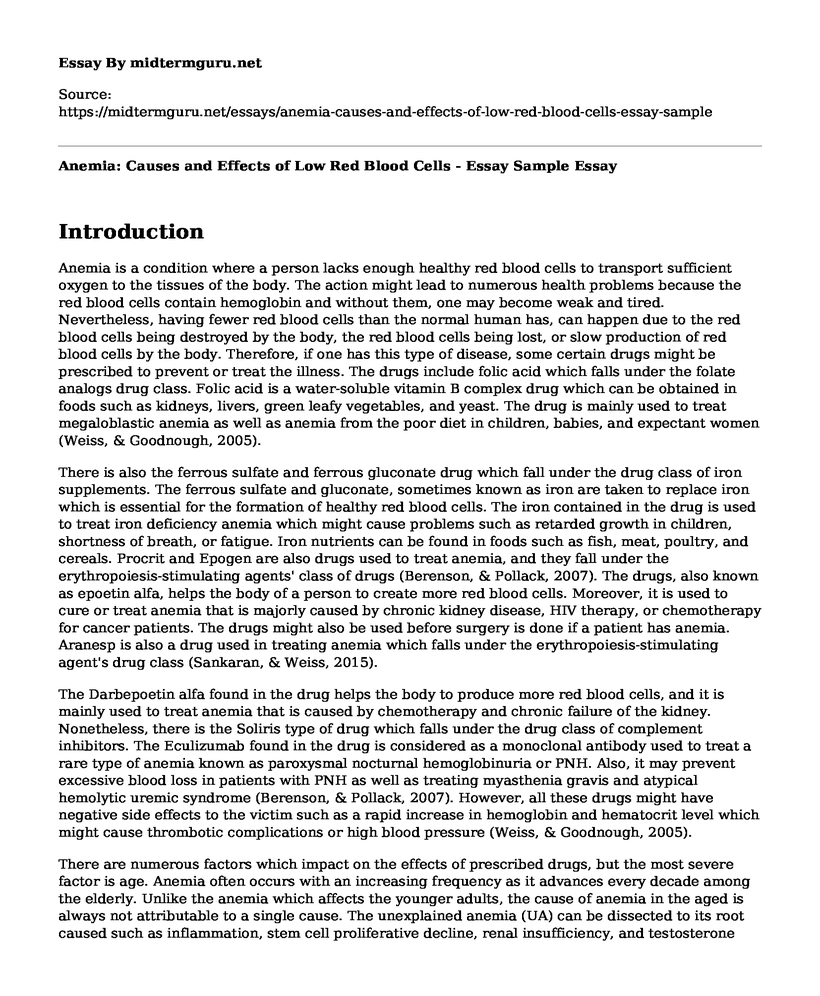Introduction
Anemia is a condition where a person lacks enough healthy red blood cells to transport sufficient oxygen to the tissues of the body. The action might lead to numerous health problems because the red blood cells contain hemoglobin and without them, one may become weak and tired. Nevertheless, having fewer red blood cells than the normal human has, can happen due to the red blood cells being destroyed by the body, the red blood cells being lost, or slow production of red blood cells by the body. Therefore, if one has this type of disease, some certain drugs might be prescribed to prevent or treat the illness. The drugs include folic acid which falls under the folate analogs drug class. Folic acid is a water-soluble vitamin B complex drug which can be obtained in foods such as kidneys, livers, green leafy vegetables, and yeast. The drug is mainly used to treat megaloblastic anemia as well as anemia from the poor diet in children, babies, and expectant women (Weiss, & Goodnough, 2005).
There is also the ferrous sulfate and ferrous gluconate drug which fall under the drug class of iron supplements. The ferrous sulfate and gluconate, sometimes known as iron are taken to replace iron which is essential for the formation of healthy red blood cells. The iron contained in the drug is used to treat iron deficiency anemia which might cause problems such as retarded growth in children, shortness of breath, or fatigue. Iron nutrients can be found in foods such as fish, meat, poultry, and cereals. Procrit and Epogen are also drugs used to treat anemia, and they fall under the erythropoiesis-stimulating agents' class of drugs (Berenson, & Pollack, 2007). The drugs, also known as epoetin alfa, helps the body of a person to create more red blood cells. Moreover, it is used to cure or treat anemia that is majorly caused by chronic kidney disease, HIV therapy, or chemotherapy for cancer patients. The drugs might also be used before surgery is done if a patient has anemia. Aranesp is also a drug used in treating anemia which falls under the erythropoiesis-stimulating agent's drug class (Sankaran, & Weiss, 2015).
The Darbepoetin alfa found in the drug helps the body to produce more red blood cells, and it is mainly used to treat anemia that is caused by chemotherapy and chronic failure of the kidney. Nonetheless, there is the Soliris type of drug which falls under the drug class of complement inhibitors. The Eculizumab found in the drug is considered as a monoclonal antibody used to treat a rare type of anemia known as paroxysmal nocturnal hemoglobinuria or PNH. Also, it may prevent excessive blood loss in patients with PNH as well as treating myasthenia gravis and atypical hemolytic uremic syndrome (Berenson, & Pollack, 2007). However, all these drugs might have negative side effects to the victim such as a rapid increase in hemoglobin and hematocrit level which might cause thrombotic complications or high blood pressure (Weiss, & Goodnough, 2005).
There are numerous factors which impact on the effects of prescribed drugs, but the most severe factor is age. Anemia often occurs with an increasing frequency as it advances every decade among the elderly. Unlike the anemia which affects the younger adults, the cause of anemia in the aged is always not attributable to a single cause. The unexplained anemia (UA) can be dissected to its root caused such as inflammation, stem cell proliferative decline, renal insufficiency, and testosterone deficiency (Pasricha, & Drakesmith, 2016). Myelodysplasia (MDS) might also be common in this age group and should be distinguished from unexpected anemia for the therapeutic and diagnostic considerations. The measures one might take to help reduce the negative side effects can be eating plenty of foods rich in iron such as lean red meat, iron-fortified cereals, beans, leafy vegetables et cetera. Also, eating and drinking foods rich in vitamin C, avoiding coffee or tea in their meals as they might affect the absorption of iron in the body and acquiring enough folic acid and vitamin B12 in a diet (Sankaran, & Weiss, 2015).
References
Berenson, A., & Pollack, A. (2007). Doctors reap millions for anemia drugs. New York Times, 5(9). Retrieved from https://scholarship.law.missouri.edu/cgi/viewcontent.cgi?article=1045&context=betr
Pasricha, S. R., & Drakesmith, H. (2016). Iron deficiency anemia: problems in diagnosis and prevention at the population level. Hematology/Oncology Clinics, 30(2), 309-325. https://doi.org/10.1016/j.hoc.2015.11.003
Sankaran, V. G., & Weiss, M. J. (2015). Anemia: progress in molecular mechanisms and therapies. Nature medicine, 21(3), 221. Retrieved from https://www.nature.com/articles/nm.3814
Weiss, G., & Goodnough, L. T. (2005). Anemia of chronic disease. New England Journal of Medicine, 352(10), 1011-1023. https://www.nejm.org/doi/full/10.1056/nejmra041809
Cite this page
Anemia: Causes and Effects of Low Red Blood Cells - Essay Sample. (2023, Jan 08). Retrieved from https://midtermguru.com/essays/anemia-causes-and-effects-of-low-red-blood-cells-essay-sample
If you are the original author of this essay and no longer wish to have it published on the midtermguru.com website, please click below to request its removal:
- Informatics for Nursing and Health Care Professionals
- Colon Cancer - Paper Example
- Community Disease Portfolio: Obesity
- A Nurses Eye-View on Health Literacy in Older Adults - Paper Example
- Paper Example on Parkinson's Disease
- My Ambition: To Become a Highly Qualified Nurse and Help Those in Need - Essay Sample
- Alternative Medicine: Exploring Options Beyond Standard Care - Essay Sample







